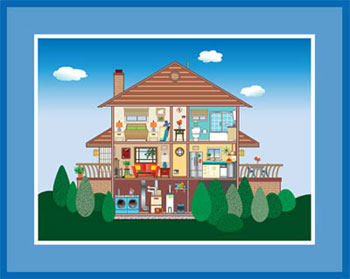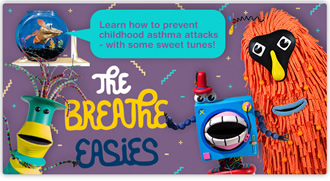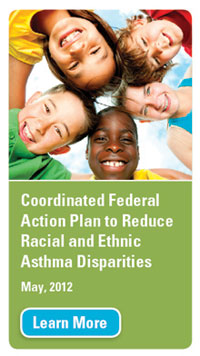Asthma Multimedia Resources
More Information
"Do you have asthma as well?"
In his weekly address, filmed at the Children's National Medical Center in Washington, D.C., the President discussed the EPA's proposal to cut pollution from power plants.
Before he left the medical center, he talked with children whose asthma is aggravated by air pollution, and who would breathe easier as a result of the proposed actions.
White House YouTube site "Take a look at what the President and the kids had to say - then pass this on:"![]()

Take the Care for Your Air Tour: Get a quick glimpse of some of the most important ways to protect the air in your home by touring the Indoor Air Quality (IAQ) House. Room-by-room, you'll learn about the key pollutants and how to address them.![]()
Partners
Mid-Atlantic Region Asthma Network(MARAN)
Join the Online Community Network:Communities in Action for Asthma-Friendly Environments Online Network is a year-round resource for mentoring and collaboration designed to support your asthma management program. Learn more about and join the Online Community Network. ![]()
Virginia's Asthma Plan:(PDF, 4.29MB, 37 pages, info about PDF)![]()
Delaware Asthma Burden Report:(PDF, 700KB, 52 pages, info about PDF)![]()
PA:(PDF, 406KB, 2 pages, info about PDF)![]()
WV:(PDF, 343KB, 2 pages, info about PDF)![]()
MD:(PDF, 360KB, 2 pages, info about PDF)![]()
DC:(PDF, 131KB, 2 pages, info about PDF)![]()
Parents and Caregivers
Smoke free Home: learn about Secondhand Tobacco Smoke and its health effects on your family. En Español
Asthma Home Checklist (PDF, 260KB, 8 pages, info about PDF)
Learn to eliminate asthma triggers in your home.
The Mid-Atlantic Center for Children's Health and the Environment (MACCHE)
Regional Healthy Homes Resource:
Health Care Professionals
Learn about asthma studies and how you can help patients manage environmental asthma triggers. ![]()
Communities in Action for Asthma-Friendly Environments Online Network
AsthmaCommunityNetwork.org is a year-round resource for mentoring and collaboration designed to support your asthma management program. Access cutting-edge tools that facilitate collaboration, problem solving, and learning between leaders of asthma programs. Learn more about and join the Online Community Network ![]()
Find information on Webinars; Discussion Forums; National Locator; Action Strategies; Pacing Events; Tools; and Recognitions Opportunities.
Climate Change refers to any significant change in measures of climate (such as temperature, precipitation, or wind) lasting for an extended period (decades or longer). Climate change may result from:
Natural factors, such as changes in the sun's intensity or slow changes in the Earth's orbit around the sun;
Natural processes within the climate system (e.g. changes in ocean circulation);
Human activities that change the atmosphere's composition (e.g. through burning fossil fuels) and the land surface (e.g. deforestation, reforestation, urbanization,desertification, etc.)
Connect with National programs

EPA is committed to raising public awareness of asthma and environmental factors that can affect asthma. To help spread the word about asthma and environmental management of common asthma triggers, EPA has developed multimedia materials that are available at no cost.
- Public Service Announcements: The Breathe Easies
- Public Service Announcement: Monsters
- Public Service Announcement: Goldfish
- Native American Asthma Radio Campaign
- Breathing Freely: Controlling Asthma Triggers Video
- Controlando los Factores del Asma Video
- Take the Asthma Quiz

In May, 2012, the President's Task Force on Environmental Health Risks and Safety Risks to Children released the Coordinated Federal Action Plan to Reduce Racial and Ethnic Asthma Disparities.
Background
Asthma is a serious, sometimes life-threatening respiratory disease that affects the quality of life for millions of Americans. Although there is no cure for asthma yet, asthma can be controlled through medical treatment and management of environmental triggers. EPA is committed to educating all Americans about asthma so that everyone knows what asthma is, how the environment can affect asthma patients and how to manage environmental asthma triggers.
Asthma Facts
- Asthma leads to 2 million emergency room visits and 5,000 deaths per year in the U.S.
- Asthma accounted for more than 14 million missed school days in 2000.
- Asthma costs (health care costs and lost productivity) totaled $14 billion in 2002.
Asthma Frequently Asked Questions
- What is Asthma?
- Who Gets Asthma?
- What Causes Asthma?
- Common Environmental Asthma Triggers
- What Happens During an Asthma Attack?
- How is Asthma Diagnosed?
- How is Asthma Treated and Controlled?
What is Asthma?
Who Gets Asthma?
What Causes Asthma?
Though many theories exist, the cause of asthma is unknown. People who have asthma tend to have airways that narrow more easily than nonasthmatics and are usually allergic to inhale allergens. A variety of factors can set off an asthma episode including cold, flu, and sinus infections, exposure to allergens (e.g. dust mites, protein particles shed by cats and dogs, and pollen); exercise; tobacco smoke; air pollution; strong emotional expressions; chemical irritants; and drugs (aspirin and beta blockers). Each person with asthma reacts to a different set of factors. Identification of these factors in an individual is a major step towards learning how to control an asthma episode. Many scientists are studying the role genetic factors play in asthma.Common Environmental Asthma Triggers
Click on the links below to learn more about Asthma triggers commonly found indoors where Americans spend up to 90% of their time and ways to reduce exposure to them:- Secondhand (cigarette) Smoke
- Cockroaches and Other Pests
- Dust Mites & House Dust
- Molds
- Pets and Other Animals
- Nitrogen Dioxide
What Happens During an Asthma Attack?
- Cells in the air tubes make more mucus than normal. The mucus is thick and sticky and tends to clog up the air tubes.
- Cells in the airways get inflamed, causing the air tubes to swell.
- The muscles around the air tubes tighten. These changes cause the air tubes to narrow and make it hard to breathe.
How is Asthma Diagnosed?
Symptoms occur or worsen in the presence of exercise, allergens, irritants, and viral infections (e.g. cold and flu). Young children whose primary symptom is a cough or who wheeze with respiratory infections are often misdiagnosed as having bronchitis or pneumonia (including acute respiratory infection, ARI), and thus are ineffectively treated with antibiotics or cough suppressants. Tobacco smokers and elderly patients frequently suffer from chronic obstructive pulmonary disease - COPD with symptoms similar to asthma. Yet they may also have asthma and benefit from treatment.
How is Asthma Treated and Controlled?
Control of asthma is defined as the absence of symptoms and acute attacks, no use of relief medication, no emergency room visits, normal activity level, including exercise, and normal lung function. To control your asthma you should know what you can do to reduce your chances of having an attack and what to do if you have an asthma episode. Talk to your doctor to set up an asthma management plan. You can download a sample Asthma Action Plan (PDF, 2 pp, 119KB, info about PDF) ![]() to help you work with your doctor to create an asthma action plan for your individual circumstances. Together, you and your doctor can monitor your asthma, determine common triggers and how to avoid them, and access the best medications to treat your asthma.
to help you work with your doctor to create an asthma action plan for your individual circumstances. Together, you and your doctor can monitor your asthma, determine common triggers and how to avoid them, and access the best medications to treat your asthma.
When you and your doctor make the plan, be sure to include:
- Your child's asthma triggers.
- Instructions for asthma medicines.
- What to do if your child has an asthma attack.
- When to call your doctor.
- Emergency telephone numbers.
Asthma Awareness Month Activities in Region III
U.S. EPA Region 3
Air Protection Division
Office of Voluntary Programs
Mail Code (3AP50)
1650 Arch Street
Philadelphia, PA 19103-2029
Fax (215) 814-2101
Toll Free 1-800-438-2474
In-state (215) 814-5000
Coordinator:
Janice Bolden
215-814-2185
Email: bolden.janice@epa.gov
Related Asthma links
![[logo] US EPA](../gif/logo_epaseal.gif)